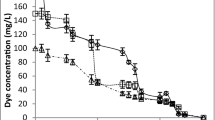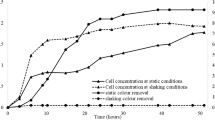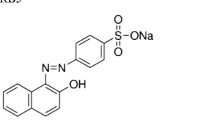Abstract
The effects of different components of real dyeing bath formulations, such as the equalizing and fixing additives—acids, salts, and surfactants—on the decolorization catalyzed by Funalia trogii enzymatic extracts, were investigated to understand their influence on the recalcitrance to biodegradation of this type of wastewater. The decolorization of selected dyes and dye mixtures after tissue dyeing was performed in the presence/absence of auxiliary compounds. All spent dyeing baths were enzymatically decolorized to different extents, by the addition of extracts containing laccase only or laccase plus cellobiose dehydrogenase. Whereas surfactant auxiliaries, in some instances, inhibit the decolorization of spent dyeing baths, in several occurrences the acid/salt additives favor the enzymatic process. In general, the complete spent dyeing formulations are better degraded than those containing the dyes only. The comparison of extracellular extracts obtained from spent straws from the commercial growth of Pleurotus sp. mushrooms with those from F. trogii reveals similar decolorization extents thus allowing to further reduce the costs of bioremediation.


Similar content being viewed by others
References
Abadulla E, Tzanov T, Costa S, Robra KH, Cavaco-Paulo A, Gübitz GM (2000) Decolorization and detoxification of textile dyes with a laccase from Trametes hirsuta. Appl Environ Microbiol 66:3357–3362
Anastasi A, Spina F, Prigione V, Tigini V, Giansanti P, Varese GC (2010) Scale-up of a bioprocess for textile wastewater treatment using Bjerkandera adusta. Bioresour Technol 101:3067–3075
Ander P, Marzullo L (1997) Sugar oxidoreductases and veratryl alcohol oxidase as related to lignin degradation. J Biotechnol 53:115–131
Baminger U, Nidetzky B, Kulbe KD, Haltrich D (1999) A simple assay for measuring cellobiose dehydrogenase activity in the presence of laccase. J Microbiol Methods 35:253–259
Bezalel L, Hadar Y, Cerniglia CE (1997) Enzymatic mechanisms involved in phenanthrene degradation by the white rot fungus Pleurotus ostreatus. Appl Environ Microbiol 63:2495–2501
Brogioni B, Biglino D, Sinicropi A, Reijerse EJ, Giardina P, Sannia G, Lubitz W, Basosi R, Pogni R (2008) Characterization of radical intermediates in laccase-mediator systems. A multifrequency EPR, ENDOR and DFT/PCM investigation. Phys Chem Chem Phys 10:7284–7292
Camarero S, Ibarra D, Martínez MJ, Martínez AT (2005) Lignin-derived compounds as efficient laccase mediators for decolorization of different types of recalcitrant dyes. Appl Environ Microbiol 71:1775–1784
Cameron MD, Aust SD (2001) Cellobiose dehydrogenase—an extracellular fungal flavocytochrome. Enzyme Microb Technol 28:129–138
Casieri L, Varese GC, Anastasi A, Prigione V, Svobodová K, Filippelo Marchisio V, Novotný C (2008) Decolorization and detoxication of reactive industrial dyes by immobilized fungi Trametes pubescens and Pleurotus ostreatus. Folia Microbiol (Praha) 53:44–52
Champagne P-P, Ramsay JA (2010) Dye decolorization and detoxification by laccase immobilized on porous glass beads. Bioresour Technol 101:2230–2235
Chivukula M, Renganathan V (1995) Phenolic azo dye oxidation by laccase from Pyricularia oryzae. Appl Environ Microbiol 61:4374–4377
Ciullini I, Tilli S, Scozzafava A, Briganti F (2008) Fungal laccase, cellobiose dehydrogenase, and chemical mediators: combined actions for the decolorization of different classes of textile dyes. Bioresour Technol 99:7003–7010
Di Gregorio S, Balestri F, Basile M, Matteini V, Gini F, Giansanti S, Tozzi MG, Basosi R, Lorenzi R (2010) Sustainable discoloration of textile chromo-baths by spent mushroom substrate from the industrial cultivation of Pleurotus ostreatus. J Environ Prot 1:85–94
Fu Y, Viraraghavan T (2001) Fungal decolorization of dye wastewaters: a review. Bioresour Technol 79:251–262
Giardina P, Faraco V, Pezzella C, Piscitelli A, Vanhulle S, Sannia G (2010) Laccases: a never-ending story. Cell Mol Life Sci 67:369–385
Golka K, Kopps S, Myslak ZW (2004) Carcinogenicity of azo colorants: influence of solubility and bioavailability. Toxicol Lett 151:203–210
Gottlieb A, Shaw C, Smith A, Wheatley A, Forsythe S (2003) The toxicity of textile reactive azo dyes after hydrolysis and decolourisation. J Biotechnol 101:49–56
Henriksson G, Johansson G, Pettersson G (2000) A critical review of cellobiose dehydrogenases. J Biotechnol 78:93–113
Hildén L, Johansson G, Pettersson G, Li J, Ljungquist P, Henriksson G (2000) Do the extracellular enzymes cellobiose dehydrogenase and manganese peroxidase form a pathway in lignin biodegradation? FEBS Lett 477:79–83
Husain Q (2006) Potential applications of the oxidoreductive enzymes in the decolorization and detoxification of textile and other synthetic dyes from polluted water: a review. Crit Rev Biotechnol 26:201–221
Johannes C, Majcherczyk A (2000) Natural mediators in the oxidation of polycyclic aromatic hydrocarbons by laccase mediator systems. Appl Environ Microbiol 66:524–528
Kandelbauer A, Maute O, Kessler RW, Erlacher A, Gübitz GM (2004) Study of dye decolorization in an immobilized laccase enzyme-reactor using online spectroscopy. Biotechnol Bioeng 87:552–563
Kaushik P, Malik A (2009) Fungal dye decolourization: recent advances and future potential. Environ Int 35:127–141
Li K, Xu F, Eriksson KE (1999) Comparison of fungal laccases and redox mediators in oxidation of a nonphenolic lignin model compound. Appl Environ Microbiol 65:2654–2660
McMullan G, Meehan C, Conneely A, Kirby N, Robinson T, Nigam P, Banat IM, Marchant R, Smyth WF (2001) Microbial decolourisation and degradation of textile dyes. Appl Microbiol Biotechnol 56:81–87
Mezohegyi G, Gonçalves F, Órfão JJM, Fabregat A, Fortuny A, Font J, Bengoa C, Stuber F (2010) Tailored activated carbons as catalysts in biodecolourisation of textile azo dyes. Appl Catal Environ 94:179–185
Pasti-Grigsby MB, Paszczynski A, Goszczynski S, Crawford DL, Crawford RL (1992) Influence of aromatic substitution patterns on azo dye degradability by Streptomyces spp. and Phanerochaete chrysosporium. Appl Environ Microbiol 58:3605–3613
Robinson T, McMullan G, Marchant R, Nigam P (2001) Remediation of dyes in textile effluent: a critical review on current treatment technologies with a proposed alternative. Bioresour Technol 77:247–255
Stapleton PC, Dobson ADW (2003) Carbon repression of cellobiose dehydrogenase production in the white rot fungus Trametes versicolor is mediated at the level of gene transcription. FEMS Microbiol Lett 221:167–172
Tauber MM, Guebitz GM, Rehorek A (2005) Degradation of azo dyes by laccase and ultrasound treatment. Appl Environ Microbiol 71:2600–2607
Vanhulle S, Trovaslet M, Enaud E, Lucas M, Taghavi S, van der Lelie D, van Aken B, Foret M, Onderwater RCA, Wesenberg D, Agathos SN, Schneider Y-J, Corbisier A-M (2008) Decolorization, cytotoxicity, and genotoxicity reduction during a combined ozonation/fungal treatment of dye-contaminated wastewater. Environ Sci Technol 42:584–589
Vasil’chenko LG, Khromonygina VV, Karapetyan KN, Vasilenko OV, Rabinovich ML (2005) Cellobiose dehydrogenase formation by filamentous fungus Chaetomium sp. INBI 2-26(-). J Biotechnol 119:44–59
Wesenberg D, Kyriakides I, Agathos SN (2003) White-rot fungi and their enzymes for the treatment of industrial dye effluents. Biotechnol Adv 22:161–187
Wolfenden BS, Willson RL (1982) Radical-cations as reference chromogens in kinetic studies of one-electron transfer reactions: pulse radiolysis studies of 2,2′-azinobis-(3- ethylbenzthiazoline-6-sulphonate). J Chem Soc Perkin Trans 2:805–812
Wong Y, Yu J (1999) Laccase-catalyzed decolorization of synthetic dyes. Water Res 33:3512–3520
Acknowledgments
We gratefully acknowledge the support of the Italian MIUR PRIN 2007 project funding and MECHOS Project, POR Ob3 Tuscany Region.
Author information
Authors and Affiliations
Corresponding author
Rights and permissions
About this article
Cite this article
Ciullini, I., Gullotto, A., Tilli, S. et al. Enzymatic decolorization of spent textile dyeing baths composed by mixtures of synthetic dyes and additives. Appl Microbiol Biotechnol 96, 395–405 (2012). https://doi.org/10.1007/s00253-011-3809-y
Received:
Revised:
Accepted:
Published:
Issue Date:
DOI: https://doi.org/10.1007/s00253-011-3809-y




